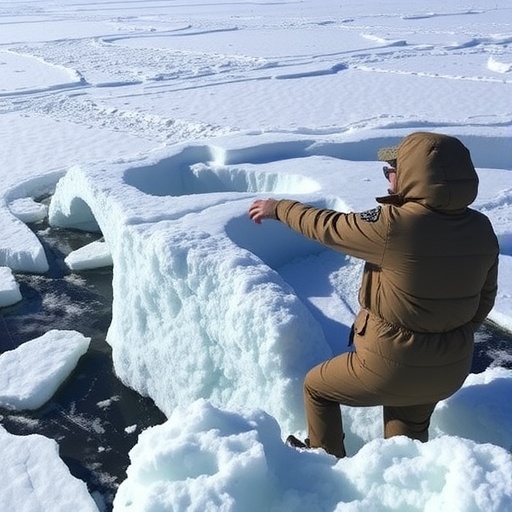In an ambitious endeavor bridging paleoclimate science and advanced Earth system modeling, Assistant Research Professor Paul Acosta of George Mason University’s Atmospheric, Oceanic and Earth Sciences program has secured substantial funding from the National Science Foundation (NSF) to investigate the complex mechanisms driving Antarctic ice growth during the Middle Miocene epoch. This transformative project, titled “Collaborative Research: Mechanisms of moisture-driven ice growth: a warm Miocene data-model comparison,” aims to unravel the intricate interplay between atmospheric moisture transport, oceanic conditions, and ice sheet dynamics spanning a pivotal interval 17 to 15 million years ago.
Central to this research is the deployment of state-of-the-art isotope-enabled general circulation models coupled with sophisticated ice sheet simulation tools. These computational frameworks will allow Acosta and his interdisciplinary team to rigorously test a suite of hypothesized processes thought to govern precipitation-driven expansion of the Antarctic ice sheet during a climatic window marked by significant warmth relative to today’s glacial conditions. By incorporating isotopic tracers into their models, the researchers intend to track the oxygen isotope signatures of precipitated water as it transitions onto the continental ice masses, yielding a finely resolved regional isotopic imprint that directly informs ice growth histories.
The approach innovatively bridges model output with paleoproxy data through the generation of a new high-resolution Antarctic ice volume record. This composite dataset will emerge from painstaking paired analyses of benthic foraminifera oxygen isotopes and magnesium-to-calcium ratios extracted from deep-sea sediment cores, the latter serving as robust proxies for past sea surface temperatures. Together, these geochemical time series enable a nuanced reconstruction of ice sheet volume fluctuations and thermal ocean conditions, both critical for validating model simulations against empirical records. Complementing these novel measurements, the team will synthesize existing geological archives spanning the Middle Miocene, fostering a holistic framework situating Antarctic ice growth within the broader Earth system context.
A profound emphasis lies in isolating the contributions of both local polar processes and broader hemispheric forcings. Locally, mechanisms such as ice-proximal ocean warmth and variability in sea ice extent are explored for their roles in modulating moisture transport and the thermodynamics of ice sheet growth. Globally, the effects of atmospheric CO₂ concentrations and orbital forcing induce shifts in poleward heat and moisture transport pathways, processes that ripple through climate systems to dictate precipitation regimes over Antarctica. By integrating these multiscalar influences, Acosta’s project ventures beyond simplistic cause-effect models to embrace the complexity inherent in paleoclimate dynamics.
This research bears significance far beyond academic curiosity, offering critical insights into the long-term drivers of global sea level change. Understanding how Antarctic ice sheets responded to warmer climates in the geologic past has immediate implications for predicting their sensitivity under future anthropogenic warming scenarios. The findings promise to enrich international collaborative efforts, including contributions to DeepMIP (Deep-time Model Intercomparison Project), which aims to benchmark climate models against deep-time intervals, and the forthcoming Intergovernmental Panel on Climate Change (IPCC) assessment reports, which rely on cutting-edge science to inform global policy.
The temporal scope of the project marks a noteworthy intersection of paleoclimate reconstruction and future climate projections. The Middle Miocene witnessed climatic conditions warmer than present, yet punctuated by episodes of Antarctic ice expansion, offering a natural laboratory to dissect mechanisms of ice sheet response to warmth intertwined with variable moisture delivery. The project’s ability to simulate isotopic signals of precipitation and ice growth provides a powerful verification tool, aligning model results with oxygen isotope ratios preserved in marine sediments to reconstruct past hydrological cycles and cryosphere evolution.
Acosta and colleagues are poised to deliver unprecedented datasets capturing the coupled isotope-hydrology-ice system. By leveraging cutting-edge analytical geochemistry alongside high-resolution climate and ice dynamics modeling, this work exemplifies a synergistic approach vital for unraveling Earth’s complex climate history. Such integration aids in reducing uncertainties that have long challenged paleoclimate reconstructions and provides a cornerstone for improved projections of ice sheet trajectories under ongoing environmental change.
The funding, totaling $237,667, supports this project from September 2025 through August 2028, underscoring the strategic investment in deep-time climate science and interdisciplinary research methodologies. George Mason University, known for fostering innovation and rigorous scientific inquiry, is proud to host research efforts that expand our understanding of the planet’s cryosphere and its integral role within the coupled Earth system.
Beyond its scientific ambitions, this project highlights the evolving role of isotope geochemistry in climate science. Employing isotopic tracers not only informs on past temperatures and ice volumes but also illuminates moisture sources, atmospheric circulation patterns, and feedback mechanisms within the climate system. These insights pave the way for more accurate reconstructions and enhance the predictive power of models tasked with forecasting future climate scenarios.
Moreover, the collaborative nature of this research fosters a productive interface between observational paleoclimatology and computational climate science. By iteratively calibrating models against high-fidelity proxy data, the team advances methodological rigor, ensuring that ensemble climate simulations better capture the spatial-temporal complexity of ancient ice sheet behaviors and their interactions with wet and warm polar environments.
As the global community intensifies efforts to understand ice sheet vulnerability amid accelerating anthropogenic climate change, investigations like Acosta’s provide indispensable historical context. They enrich scientific discourse on the thresholds and feedbacks determining ice sheet stability, contributing to more robust risk assessments for coastal populations and ecosystems worldwide threatened by rising seas.
In summary, Paul Acosta’s NSF-funded project ventures to decode the enigmatic processes by which Antarctic ice sheets expanded during a warmer Middle Miocene, employing a cutting-edge data-model fusion strategy rooted in isotope hydrology and dynamical ice modeling. Through this work, the research promises to shed new light on paleoclimatic moisture dynamics, ice volume fluctuations, and their implications for future sea level trajectories, cementing a crucial link between Earth’s climatic past and its unfolding future.
Subject of Research: Mechanisms driving moisture-influenced Antarctic ice growth during the Middle Miocene; isotope-enabled climate and ice sheet modeling; paleoclimate data-model synthesis.
Article Title: (Not provided)
News Publication Date: (Not provided)
Web References: http://www.gmu.edu/
References: (Not provided)
Image Credits: (Not provided)
Keywords: Atmospheric science, Earth sciences, Physical sciences




